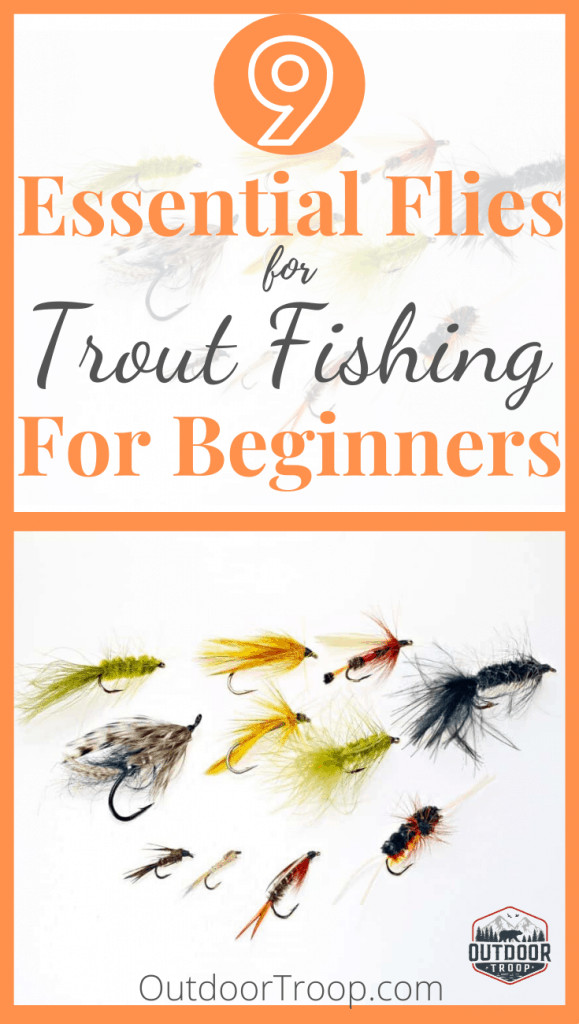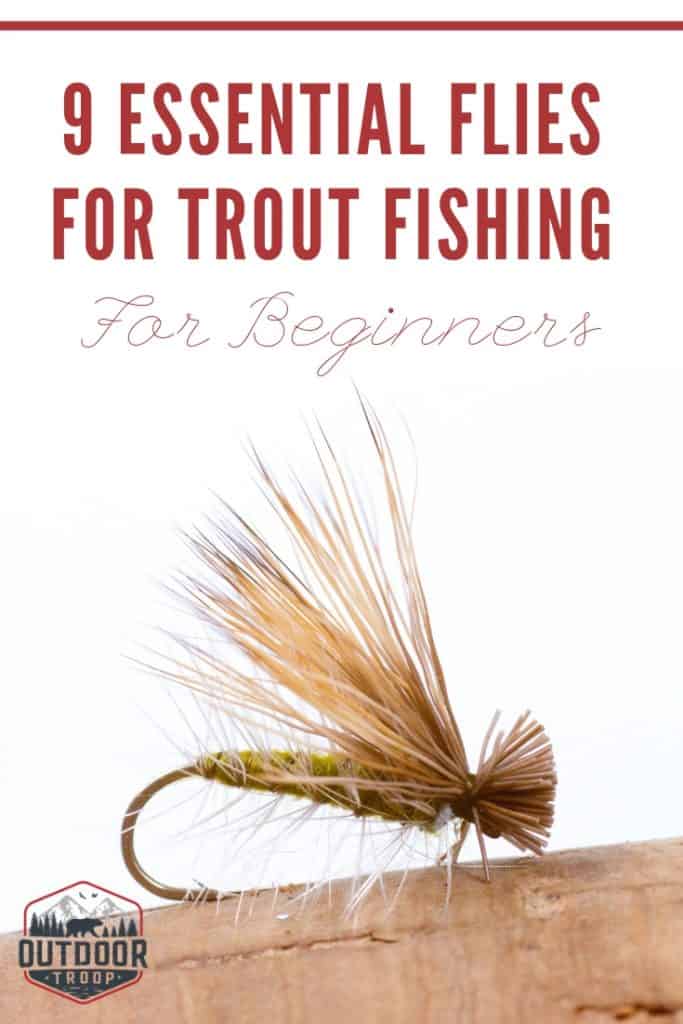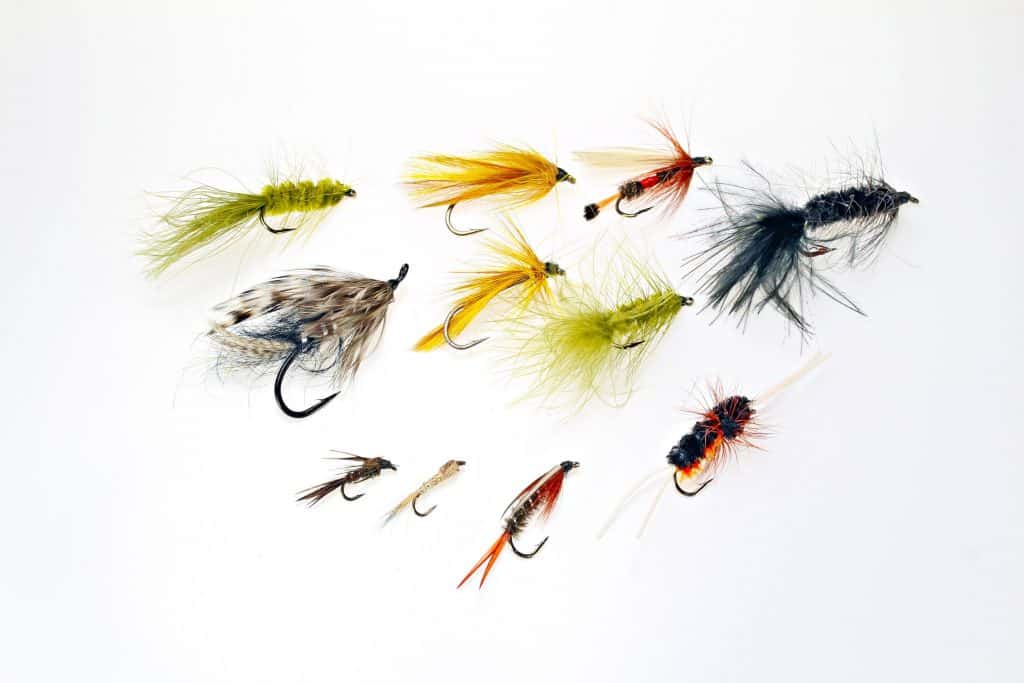
If you are just beginning to learn how to fly fish for trout, knowing which fly to use can be a little difficult. Every fly fisherman should have some essential trout flies in order to make their fishing trip a success.
So what are the 9 essential flies for trout fly fishing for beginners? Our top 9 picks for essential trout flies are:
- A Parachute Adams
- An Elk Hair Caddis Fly
- A Pheasant Tail Nymph Fly
- A Bead Head Woolly Bugger Fly
- A Gold Bead Hare’s Ear Fly
- A Muddler Minnow Fly
- A Soft Hackle Fly
- An Olive Freshwater Clouser Fly
- A Gnat Fly
For beginner fly fisherman the difference in all the flies can seem quite confusing (some sound made up even). However, choosing the correct fly to put on the end of your line is an important part of fly fishing. Read on below to learn the difference in each of these flies and how you can use them in your next fly fishing trip.
The 9 Essential Trout Flies Explained
You should always know the reasoning behind your choice in flies.
Don’t just follow any advice you find on choosing your flies. Knowing which fly to use takes requires knowing what the trout around you are eating and what each fly is designed to imitate.
Parachute Adams
The Parachute Adams fly is widely known by fisherman as
This is a dry fly used for catching those trout that rise to the surface.
This fly can be used during a mayfly hatches, caddis hatches, and for some midge hatches.
If you are hoping to imitate a mayfly or caddis hatch opt for a Parachute Adams with a size between 10 or 20. For midge hatches a smaller size will work best.
The Parachute Adams fly makes it on our essential 9 flies list simply because it is a versatile fly designed to imitate several different species of insects throughout several different seasons.
If you choose not to use the Parachute Adams fly, many of the flies from the Adams dry fly collection are just as effective.
Elk Hair Caddis Fly
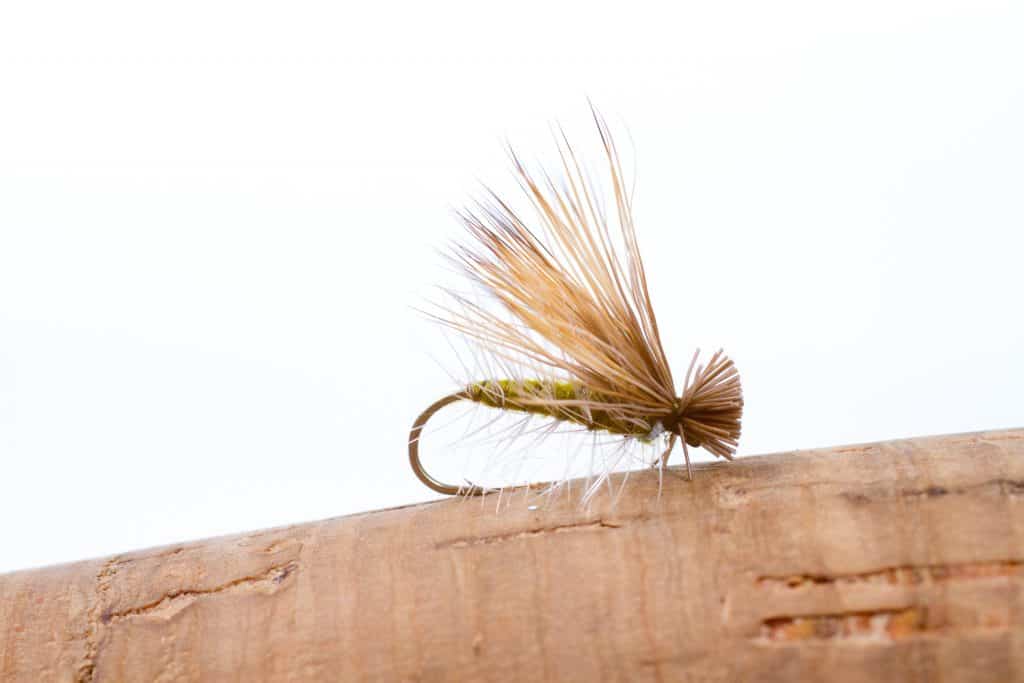
While the Parachute Adams is considered the most effective fly fishing fly overall, an Elk Hair Caddis Fly takes credit as one of the most effective trout dry flies.
Some Elk Hair Flies are said to ride to high on the water. If this is a concern of yours while fly fishing, check out some of the low rider options.
The Elk Hair Caddis is not as versatile in imitating species; however, it is effective in imitating a caddis each time. Trout tend to be tricked by this fly’s appearance each and every time.
Definitely add an Elk Hair Caddis Fly to your tackle box if you plan on fishing for Trout on your next fishing excursion!
Pheasant Tail Nymph
The Pheasant Tail Nymph looks exactly as you would picture it. This fly resembles miniature pheasant perfectly.
This fly is perfect for fishing at any time of the year and comes either with or without the bead.
The Pheasant Tail Nymph mimics several different species of bait and therefore is another versatile fly that you can’t leave out of your tackle box!
If you are fishing in an area where fish may be easily spooked for heavy amounts of fishing, then perhaps the bead-less nymph is the best choice for you.
Having a couple of each style of Pheasant Tail Nymphs packed with your other flies will not weigh you down and will definitely add to your overall fishing experience.
Bead Head Woolly Bugger
The Bead Headed Woolly Bugger is one of those flies that just seems to do the trick when it comes to catching large trout.
This fly imitates several different kinds of bait that trout can’t resist taking a bite out of.
The design of this fly helps it to appear more life-like as well. This more life-like appearance draws in the larger more aggressive trout.
Not only is this fly able to imitate several different bait species, but you can fish with this fly with either a dead-drift or under a strike indicator. Making this one of the most versatile and effective flies to fill your tackle box with.
The most effective sizes for catching trout with a woolly bugger are anywhere between a 6 or a 12.
The Woolly Bugger is another fly that easily compares to the Parachute Adams and is sure to be found in any trout fly fisherman’s tackle box.
Muddler Minnow Fly
The Muddler Minnow can be compared to the Clouser Minnow for its effectiveness when fly fishing.
However, the Muddler Minnow is claimed by many fishermen to be more effective when landing trout than its Clouser relative.
Wherever (or whenever) you choose to go use the Muddler Minnow Fly, you can use it differently to imitate several different species of trout food.
Treated like a dry fly it mimics a grasshopper on the surface. When sent through a deep pool, trout mistake it for sculpin. You can even use the Muddler Minnow at night to imitate a mouse.
When catching trout, utilizing the classic Muddler Minnow Fly might just be the way to land that trout you’ve been searching for.
Soft Hackle Fly
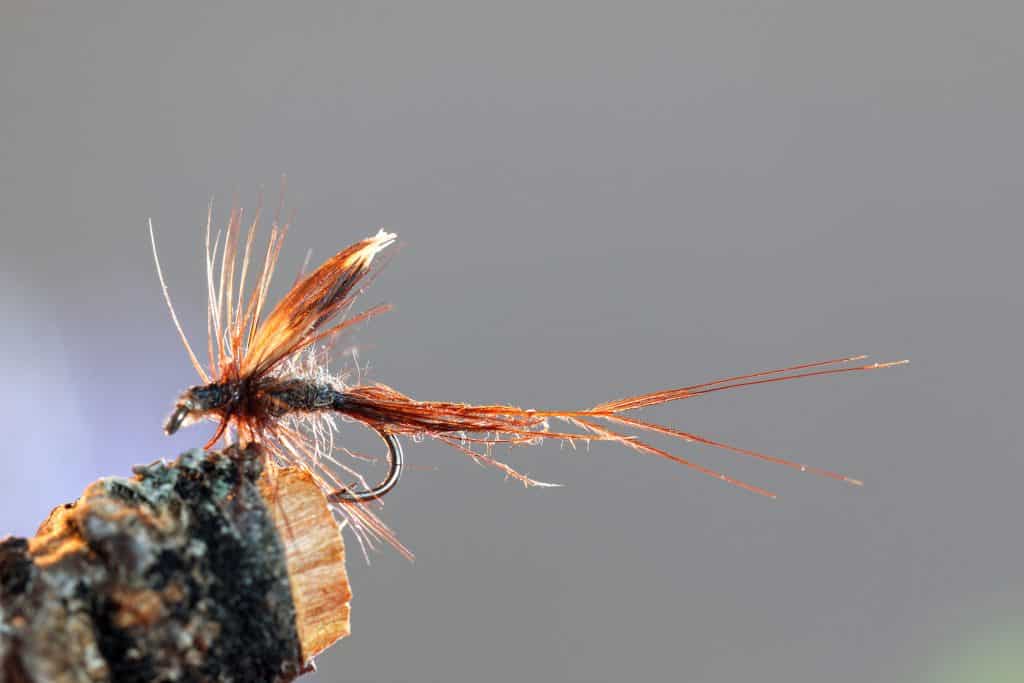
The Soft Hackle Fly is known for being able to imitate many different styles of trout food and gives the Woolly Bugger a run for its money out on the water.
The Soft Hackle can also be fished in a variety of different ways to help you catch more trout.
You can dead-drift a soft hackle, put it under a strike indicator, swing it under some tensions, or even attempt to perfect the “drift and lift” that much more experienced fly fisherman say is the soft hackle’s claim to fame.
The Soft Hackle is said to be one of the most effective flies for fishing in the plentiful Montana waters when searching for trout.
Be sure to have a couple of the Soft Hackle Fly varieties with you on your next fishing trip!
Clouser Minnow Fly
The Clouser Minnow is a fly that can come quite in handy when you need a fly to imitate a baitfish with.
The Clouser Minnow and the Muddler Minnow are close relatives that give each other a run for their money when used for fly fishing for trout.
While the Muddler Minnow is said to be more effective than the Clouser when landing a trout while fly fishing, a light Clouser Minnow streamer might just be what you need to hook a trout.
While your tackle box does not need to be packed full of streamers, having a few different variations gives you some options to test out when
Be sure to bring a light streamer with you to help imitate baitfish. A size 6 or 8 Clouser Minnow Fly is sure to be effective on your next trout fly fishing trip!
Gnat Fly
While a gnat fly may be small and
The gnat fly is said to be an essential fly for every fly fisherman’s midge box, and going out on the water without one would be a mistake.
The gnat fly is designed to imitate small insects, beetles, or other small trout food.
When used during a midge hatch a gnat fly can be extremely effective. Another effect time to use this fly is during a hatch of small caddis or mayflies.
If you can’t seem to decide what the fish in the water are eating, tie a gnat fly on your line. No matter what they are eating, you are sure to catch some fish.
An effective size for catching trout is anything between size 14 or 22.
Be sure to have a fair assortment of Gnat Flies for when you just need that something special to reel in a trout.
Dry Fly versus Wet Fly
While there are many different styles of flies to take with you on your fishing trip, they can all be sorted into two main categories.
These two categories are dry flies and wet flies. You may be asking which type will be most effective for your next fishing trip. However, both are extremely effective and essential for your next fly fishing excursion.
To understand when you should use a dry fly or a wet fly, it is important to know the differences and uses for each type.
Dry Flies
Fly fishing with the use of a dry fly
The task of a dry fly is to imitate an insect that fish tend to snack on. Dry flies sit on the surface of the water bringing the hungry fish to the surface in order to take a bite.
While casting a dry fly, the fly fisherman’s goal is to land the fly on the surface as naturally as possible (just like a real bug would) so as not to spook and nearby fish that may be watching.
After casting the dry fly out, a fly fisherman begins focusing on achieving what is known as the “dead-drift.” A dead drift is simply when the fly floats at the same rate as the current without any drag caused by the line.
While this may be a little more difficult than fly fishing with a wet fly, it can be extremely effective when used correctly.
The challenge of tricking a fish into believing your fly really is an insect sitting upon the water makes fly fishing with a dry fly (and actually catching a fish) more of an achievement.
Not only is using the tricky dry fly an achievement but since the fly sits upon the surface of the water, it allows you to see the fish strike.
Being able to see the fish makes it easier to know when to strike. As well as that it makes it way more exciting when you see a fish approaching your fly!
Wet Flies
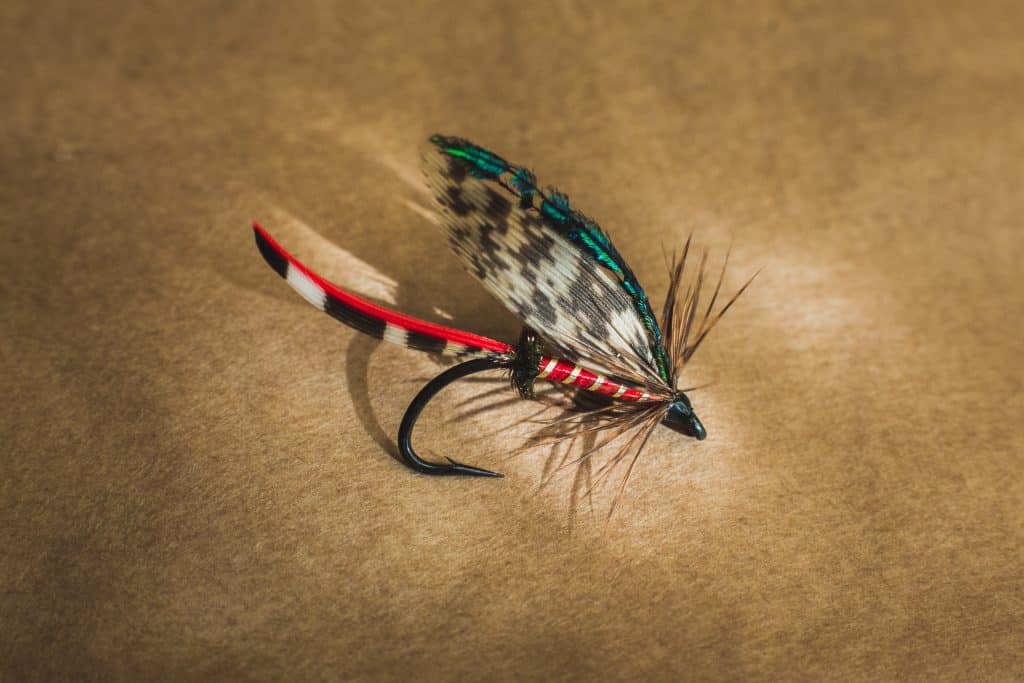
A wet fly is designed to specifically imitate the insects that live below the water’s surface prior to hatching.
Some wet flies are also used to mimic crawfish, leeches, and smaller baitfish.
A wet fly is the best type of fly for beginners to start learning how to fly fish with.
So why is the wet fly the best fly for beginners?
This is simply because the heavier wet flies are just easier to cast. So if you are just learning how to cast with a fly rod, a heavier fly is easier to cast further.
Fly fishing with a wet fly does not require as much of the delicacy that dry fly fishing does.
Wet flies are used when targeting the fish that lurk in the deeper waters and are less likely to rise to the surface.
Fish that stay in the deeper parts of the water are known for striking more willingly than surface feeding fish.
A fish on the surface will be more skeptical of any fly that lands unnaturally or that doesn’t quite resemble their favorite insects.
However, bottom feeders are not as skeptical and tend to not notice any discrepancies with your cast or fly.
The downside to fly fishing with a wet fly is that you can’t see the fly or the fish.
Because you can not see the fly or fish, it can make it harder to distinguish a fish taking a bite on your line, or a snag on the bottom of the river.
Any experienced fisherman will tell you,
A common practice in fly fishing with a wet fly is to put two or three different flies on the line in order to up the chances of a fish striking.
Once the fisherman knows which fly the fish are preferring to take, they may switch to only using that fly.
The Two Types of Flies
Now that you know the difference in the two types of flies used in fly fishing, you can better understand which flies to bring with you (definitely bring our 9 essential flies!) and when to use them!
Test out different dry flies and wet flies so that you can understand truly how they all act on the water and how the fish react to them.
If you are looking for a creative way to fish, I have seen fishermen cast out with both a dry fly AND a wet fly on their line.
This tactic helps the fisherman to cover more of the water in a shorter amount of time and to reach all the different fish in the water.
Related Questions:
Can you fly fish on lakes? Fly fishing can be used in many different styles or types of water. While fly fishing on rivers is most common, fly fishermen can be seen on lakes or even out on the ocean enjoying the sport.
Is it better to fly upstream or downstream? The direction you cast your fly can depend on the style of fly you are using, the area you are fishing in, and the type of fish you are hoping to catch. To achieve the perfect “dead-drift” many fly fishermen choose to cast upstream.
